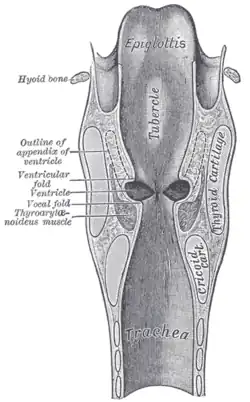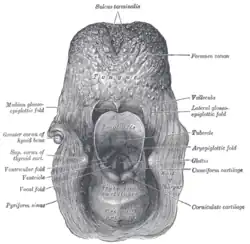Laryngeal ventricle
| Laryngeal ventricle | |
|---|---|
 Coronal section of larynx and upper part of trachea, with Ventricle labeled at center left. | |
| Details | |
| Identifiers | |
| Latin | ventriculus laryngis |
| TA98 | A06.2.09.010 |
| TA2 | 3206 |
| FMA | 64171 |
| Anatomical terminology | |
The laryngeal ventricle, (also called the ventricle of the larynx, laryngeal sinus, or Morgagni's sinus)[1] is a fusiform fossa, situated between the vestibular and vocal folds on either side, and extending nearly their entire length. There is also a sinus of Morgagni in the pharynx.
The fossa is bounded, above, by the free crescentic edge of the vestibular ligament; below, by the straight margin of the vocal fold and laterally, by the mucous membrane covering the corresponding thyroarytenoid muscle.
The anterior part of the ventricle leads up by a narrow opening into a pouch-like diverticulum, a mucous membranous sac of variable size called the appendix of the laryngeal ventricle. The appendix (also called the laryngeal saccule, pouch or Hilton's pouch) extends vertically from the laryngeal ventricle. It runs between the vestibular fold, thyroarytenoid muscle, and thyroid cartilage, and is conical, bending slightly backward. It is covered in roughly seventy mucous glands. The muscles surrounding the appendix compress it until mucus is secreted to lubricate the vocal folds.
Additional images
 The entrance to the larynx, viewed from behind.
The entrance to the larynx, viewed from behind. Cut through the larynx of a horse
Cut through the larynx of a horse
References
![]() This article incorporates text in the public domain from page 1080 of the 20th edition of Gray's Anatomy (1918)
This article incorporates text in the public domain from page 1080 of the 20th edition of Gray's Anatomy (1918)
- ↑ Medical Definition of Laryngeal sinus in lexic.us. Updated 05 Mar 2000
External links
- "Ventricle of larynx". Medcyclopaedia. GE. Archived from the original on 2012-02-05.
- lesson11 at The Anatomy Lesson by Wesley Norman (Georgetown University) (larynxsagsect)